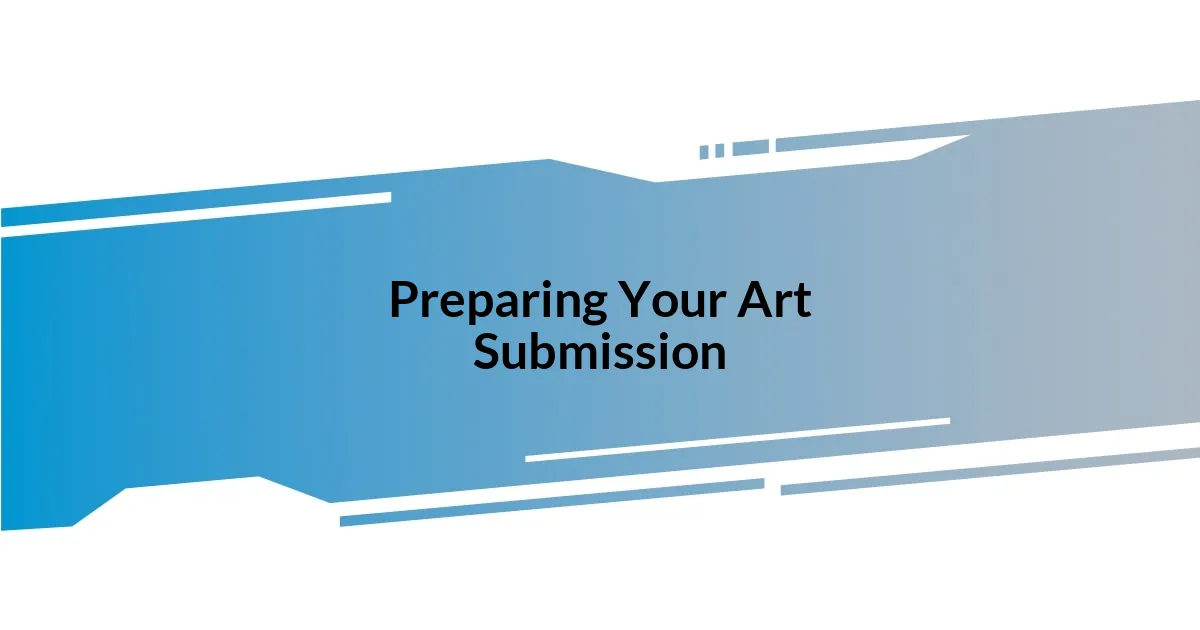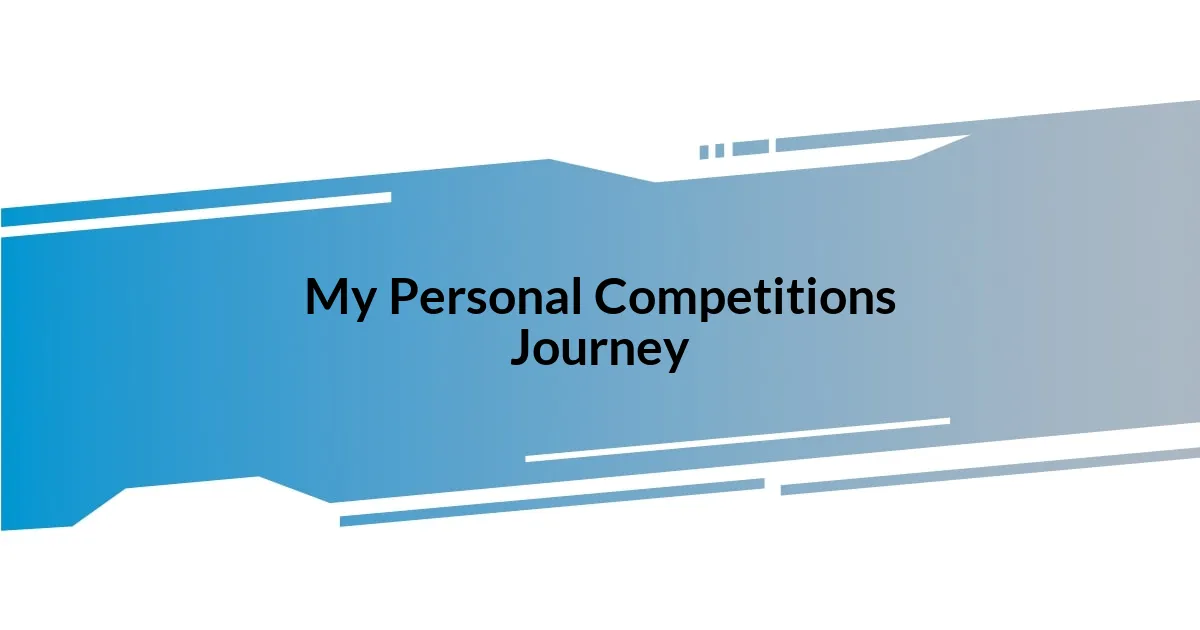Key takeaways:
- Art competitions serve as platforms for self-discovery, community connection, and artistic growth.
- Understanding different art categories enhances creativity and allows for innovative expression.
- Preparation is crucial, including adhering to submission guidelines, presenting artwork effectively, and using high-quality images.
- Resilience, authenticity, and building connections are essential lessons learned through competitive experiences.

Introduction to Art Competitions
Art competitions can feel like thrilling adventures, full of excitement and uncertainty. I remember my first competition vividly; standing in front of my artwork, I felt a mix of pride and anxiety. It got me wondering: what does it really take to stand out in such a vibrant and diverse field?
Beyond the thrill, these competitions open a window to self-discovery. When I created my piece for a local exhibit, I poured not just my skills, but also my emotions into it. Each brush stroke was a moment of vulnerability—did others feel the way I did while gazing at it? The pressure of judging can be daunting, yet it pushes artists to evolve and refine their craft.
What I’ve realized over time is that art competitions are more than just accolades; they’re platforms for connection. They foster a sense of community and celebration among artists. I’ve met incredible people who inspired me through their creativity, reminding me that every piece has a story and every artist has a unique voice.

Understanding Different Art Categories
Understanding different art categories can feel overwhelming at first, as each category has its unique charm and challenges. For instance, when I entered a photography competition, I was surprised by the variety of categories from portrait to landscape. Each demanded a distinct approach that shaped my understanding of artistic expression.
Here are some common art categories to consider:
– Painting: Encompasses styles like realism, abstraction, and impressionism, each offering a different perspective.
– Sculpture: Involves three-dimensional work, where materials can range from clay to metal.
– Photography: Divided into categories like portraiture, documentary, and commercial, showcasing different storytelling techniques.
– Mixed Media: Combines various technologies and materials, allowing for innovative dimensions.
– Digital Art: Embraces technology and software, pushing boundaries on traditional art forms.
During my artistic journey, the challenge of defining my style within these categories became an opportunity for growth. The more I explored, the more I realized how interconnected these categories truly are. When I combined digital art techniques with traditional mediums, I felt an exhilarating sense of freedom that expanded my creative horizons. Each category is not just a label; it offers a pathway for storytelling, inviting us to express our unique perspectives in distinctive ways.

Preparing Your Art Submission
When preparing your art submission, one essential step is to thoroughly read the submission guidelines. I learned this the hard way after submitting a piece that didn’t adhere to the required dimensions. It wasn’t just a missed opportunity; it was a lesson in attention to detail. Each competition has its own rules, and being aware of them can save you a lot of heartache.
Another critical aspect is to put thought into your artwork presentation. When I showcased my work for the first time, I chose a simple yet impactful frame that accentuated my piece. I quickly realized that the way your art is presented can significantly enhance its appeal. Think of it this way: a well-framed piece invites viewers in, making them more likely to appreciate the intricate details and intent behind it.
Lastly, I can’t stress enough the importance of submitting high-quality images if you’re not able to present your art in person. During my last competition, I meticulously captured my artwork under natural light, ensuring the colors were true to life. This helped my piece stand out among the submissions. Remember, your artwork deserves to be seen in its best light, literally!
| Aspect | Importance |
|---|---|
| Submission Guidelines | Understanding rules avoids disqualification. |
| Artwork Presentation | A well-presented piece enhances viewer engagement. |
| Image Quality | High-quality images showcase artistic details effectively. |

Tips for Creating Winning Artwork
Creating artwork that stands out in competitions is both an art and a science. One tip I often share is to choose a theme that resonates with you personally. When I focused on a topic that I was passionate about, my creative energy seemed to flow more freely. Have you ever noticed how your emotions influence your brushstrokes or color choices? It’s like translating a feeling into visual language, which can deeply connect with judges and viewers alike.
In my experience, experimenting with different techniques can lead to unexpected breakthroughs. I remember trying out a new layering method with my painting that added a rich texture I hadn’t achieved before. It was thrilling to see how a bit of innovative experimentation transformed my piece. What if you stepped outside of your usual comfort zone? You might just discover a new dimension to your art.
Lastly, don’t underestimate the power of storytelling in your artwork. When I entered a narrative-themed competition, I crafted a backstory for each piece. This narrative context not only guided my creative decisions but also engaged the judges on a deeper level. Can you imagine how they felt when I shared the inspiration behind my artwork? It made the experience more memorable for everyone involved. Your art has a voice; let it tell a story that captivates and invites others to step into your world.

The Judging Process Explained
Judging in art competitions often begins with the initial review of submissions, with judges assessing pieces based on established criteria like creativity, technique, and emotional impact. I remember the anticipation I felt the first time my work was laid bare to the scrutiny of seasoned judges — it was nerve-wracking yet exhilarating. There’s something deeply fascinating about seeing how experienced artists interpret your intentions through their professional lens.
Once the initial wave of submissions is filtered, judges typically engage in more detailed discussions about the standout pieces. I vividly recall a competition where I overheard judges passionately debating the symbolism in one entry. It sparked an epiphany in me: art is not just about aesthetics; it’s also a dialogue with the viewer. How do you think your work communicates its message? Understanding this dynamic can significantly influence how you approach future submissions.
Finally, feedback plays a crucial role in the judging process. After receiving critiques from a previous competition, I felt both vulnerable and empowered; their insights challenged me to grow. Receiving constructive feedback can be painful but can also pave the way for artistic development. Have you ever taken a risk only to receive mixed reactions? Embracing that discomfort can ultimately enrich your practice and sharpen your vision as an artist.

My Personal Competitions Journey
Looking back, I’d say my journey in art competitions began as a timid foray into a world that felt both thrilling and intimidating. I remember nervously submitting my first piece—a watercolor painting of my childhood backyard. The anticipation was palpable; I could hardly sleep, wondering if my work would resonate with anyone. Have you ever felt that mix of hope and dread? It was a pivotal moment that ignited my passion for creating art that connects with others.
As I continued to participate, there was one competition experience that stood out vividly in my mind. I had created a piece inspired by a dream I once had, filled with swirling colors and ethereal shapes. When I presented it, I was shocked by the reactions; people shared how it made them feel, triggering their memories and emotions. It was in that moment I realized that art could transcend the canvas—it could be a shared experience. How powerful is it to tap into someone else’s emotional landscape through your work?
Gradually, I developed a thicker skin and started to see competitions as opportunities for growth rather than tests of my worth as an artist. One year, I submitted a piece that I honestly thought was my best work yet, only to receive less-than-stellar feedback. Instead of feeling defeated, I dissected the critiques and used them to fuel my next creation. I remember thinking, “What can I learn from this?” That shift in perspective helped me embrace the competitive landscape as a fertile ground for evolution, and in hindsight, I wouldn’t trade those lessons for any trophy.

Lessons Learned from Art Competitions
Participating in art competitions has taught me that resilience is just as important as talent. I vividly recall a time when I poured my heart into a mixed-media piece, only to receive a lukewarm response. It stung, but it also ignited a determination in me to refine my skills. Have you ever felt that urge to prove yourself after a setback? It’s an enlightening feeling to realize that each challenge can be a catalyst for growth.
Another lesson I’ve internalized is the significance of authenticity in my work. At one competition, I experimented with a style that wasn’t true to my voice, hoping it would be more appealing. The result? A disheartening disconnect with the audience and judges. Reflecting on that moment, I learned that genuine expression resonates much deeper. How often do we compromise our vision in pursuit of acceptance? Finding my true artistic identity has since become my north star.
Lastly, art competitions have taught me the value of community and connections. I remember striking up a conversation with fellow participants during one event, exchanging ideas and perspectives that enriched my own practice. It reminded me of how collaboration can open up vast new avenues of creativity. Have you ever found fresh inspiration in unexpected places? Engaging with others shapes not only our art but also our journeys as artists, reminding us that we’re never alone in this creative landscape.